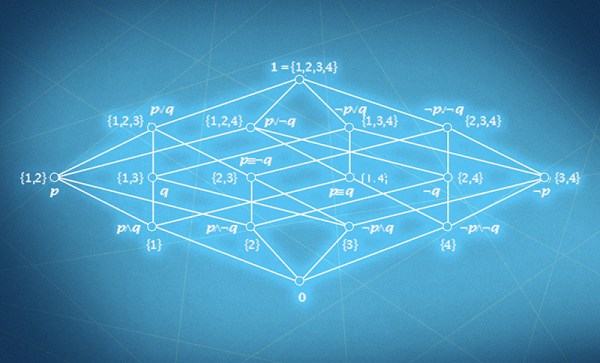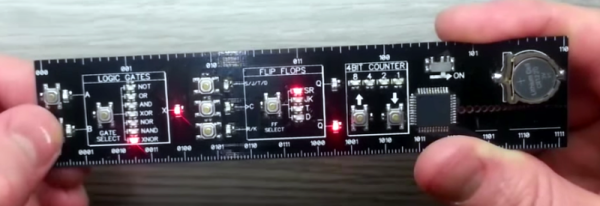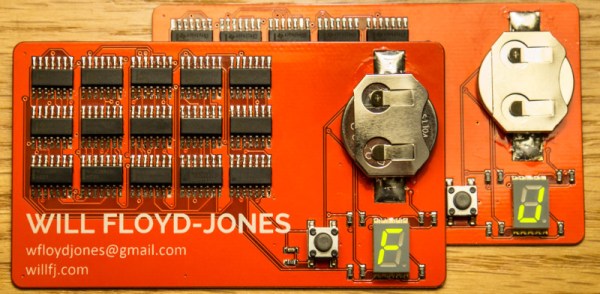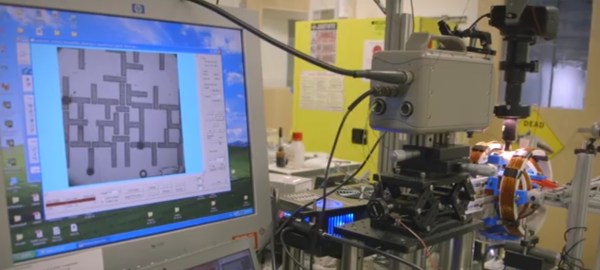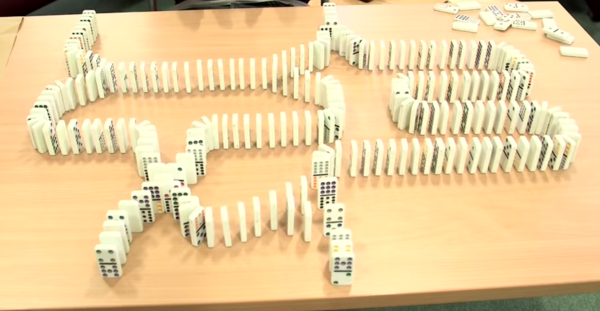We return once again to the work of Dr. Claude E. Shannon, this time to his Masters thesis on relay switching circuit design. This thesis introduced switching algebra that allows the systematic design and optimization of logical circuits. While Shannon’s work applied to switches and relays, it is equally applicable to all the modern forms of digital circuits. His thesis received widespread notice when published as “A Symbolic Analysis of Relay and Switching Circuits” in 1938. This work built on the Boolean algebra developed by George Boole and an analysis of logic by Augustus De Morgan which these mathematicians published nearly simultaneously in 1847. To some extent, it was the beginning of the age of modern digital logic. Continue reading “Designing Circuits With Switching Algebra”
logic gates16 Articles
Electronic Ruler Works Out Logic Truth Tables
Like [Brad], we’ve seen a number of PCB rulers out there. [Brad] was looking to take the idea and run with it. His DigiRule is a ruler with a logic gate simulator. What he built is a mash-up between PCB rulers, and the concept of electronic business cards.
All told it simulates seven logic gates, four flip-flops, and includes a four-bit counter. On one end of the ruler a CR1220 battery feeds the 18F43K20 which is performing the logic operations using buttons and LEDs. Of course the truth tables are printed on the back silk-screen, but playing with the lights is a lot more fun. We do find it fairly amusing that the centimeters on the bottom of the ruler are notated in binary.
It makes a lot more sense to hand out rulers than business cards; people might actually use them after you leave and you can still include contact info. This form-factor also breaks the mold. You can have a lot more space on a ruler and you’re not constrained by thickness (although [Limpkin] solved that problem). While we’re on the topic of business cards [ch00f’s] USB etch-a-sketch style card and this logic-based information delivery device top our favorites list.
Continue reading “Electronic Ruler Works Out Logic Truth Tables”
This PCB Business Card Is Logically Different
Having seen a number of PCB business cards [Will] decided to go against the more popular choice of a micro-controller based design and show some character with a logic based finite state machine. [Will] uses a single 7-segment display to scroll through the letters of his name with a state machine that outputs the desired combination of 1’s and 0’s to the LED display each time the tactile button is pushed.
[Will] uses a 4-bit counter made up of D Flip-Flops for the clock signal as a conditional input to 6 of the 4-input AND gates. He doesn’t go into the painful details of displaying each character through the process (thankfully) but he does mention that he uses the Quine-McCluskey technique for reduction instead of Boolean algebra. Since his name is 11 characters long and the 4-bit binary counter goes from 0000 to 1111 leaving 5 more pushes of the button before rolling the count back to 0000, during which time the display is left blank. [Will] kindly includes the eagle and Gerber files for your downloading pleasure over at his blog if you’re interested in getting a little deeper into the design.
Continue reading “This PCB Business Card Is Logically Different”
Manipulating Matter In A Digital Way
On a fundamental level a computer’s processor is composed of logic gates. These gates use the presence of electricity and lack thereof to represent a binary system of ones and zeros. You say “we already know this!” But have you ever considered the idea of using something other than electricity to make binary computations? Well, a team at Stanford University has. They’re using tiny droplets of water and bar magnets to make logic gates.
Their goal is not to manipulate information or to compete with modern ‘electrical’ computers. Instead, they’re aiming to manipulate matter in a logical way. Water droplets are like little bags that can carry an assortment of other molecules making the applications far reaching. In biology for instance, information is exchanged via Action Potentials – which are electrical and chemical spikes. We have the electrical part down. This technology could lead to harnessing the chemical part as well.
Be sure to check out the video below, as they explain their “water computer” in more detail.
Learning Logic Gates With Dominos
Even though most of us know logic gates like the back of our hands, we just found this awesome explanation video you can use to teach kids in a very fun way — Using nothing but dominoes.
Produced by [Numberphile], our host sets up various “circuits” using dominoes to explain all the various logic gates. Some of the patterns are a bit tricky to setup since you actually have to set up timing based on the spacing of the dominoes — makes us wonder how many bloopers there were!
But don’t take our word for it, it’s well worth a watch after the break.
Hackaday Links: Christmas Eve, 2012
It’s Christmas Eve, the perfect time to interact with your extended familial units, eat cookies, nog things up a little, and watch Die Hard. Christmas Eve also means it’s a low-effort day here at Hackaday, so here’s a few cool things we’ve run across in the past few weeks.
A Round OLED Display
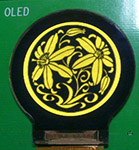
That right there is a circular OLED display. [ArtistEngineer] over on reddit found this display on AliBaba. It’s a 1.13 inch diameter display with a resolution of 128×128 (yeah, we don’t know either). This looks like a great display for a DIY wrist watch, digital gauge, or loads of other devices where a square display doesn’t make much sense.
There seems to be a few circular OLED display manufacturers – including Truly Semiconductors who happened to put up a datasheet for their round display – but sourcing these in reasonable quantities is a pain. Anyone up for a group buy? Think of the fun you’ll have coding a polar coordinate display!
Computing with transistors

So you know computers are made up of simple logic gates, latches, buffers, and other miscellaneous digital cruft, but how do we turn these digital circuits into a computer? Over the last few months, [Andrew] has been putting up a bunch of blog posts on the application of digital logic. Start out on the ‘Computing with Transistors’ post before moving on to The Digital State and Circuits and Arithmetic. There’s some good readin’ there.
Embedding 3D objects in a web page
Go ahead. Click it. It’s Sketchfab that allows anyone to publish interactive 3D designs without a browser plugin. If anyone out there is trying to build a Thingiverse clone that isn’t tied to Makerbot, consider using this for the preview page for each object.
Surprisingly, Twinkies were the one thing that didn’t survive the Apocalypse.

While there’s no use in mourning the death of the Twinkie – Little Debbie also makes small cream-filled cakes – you might as well include some Twinkies, Snowballs, Ding Dongs, and Ho-Hos in your Christmas baking. [scoochmaroo] on Instructables put together a list of homebrew recipes for the now defunct Hostess snack cakes.
Perfect for autonomous robots
![]()
[maxogden] over on the gits put together a script for automatically joining wireless networks on Linux. This was tested on a Raspberry Pi, and we’re thinking it would be perfect for whatever autonomous creation you’ll be building in your workshop next year.
How Computers Work, Starting With Transistor Gates
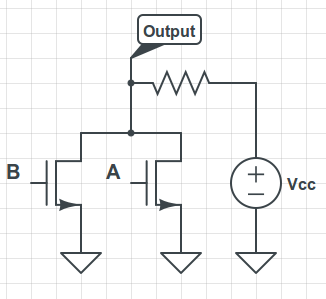
[Andrew Gibiansky] has just started a tutorial series called Computing with Transistors. It’s purpose is to pull back the many veiled layers between high level languages and the controlling of electrons. And fittingly this first post starts off by explaining voltage source, load, and current. Don’t be thrown by its simplicity though. [Andrew] quickly moves on to talk about switching transistors and how they are used to build gates like the OR NOR gate seen above.
If this is the least bit interesting you should also look back at the post about Nand 2 Tetris. It’s an online course that works its way through The Elements of Computing Systems text book. We’ve been following that journey ourselves, having made it through the hardware build in about a week. The assembler took about the same amount of time, and right now we’re in debugging hell trying to get the last function call and return parts of the VM translator to work right. We’ve used most of the skills needed in this journey before, but never all in one project. It really has shed a lot of light on the gaps in our knowledge, and we’re having a lot of fun at the same time!
[via Reddit]

